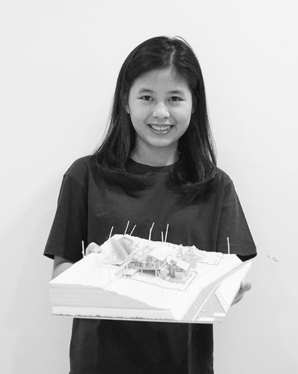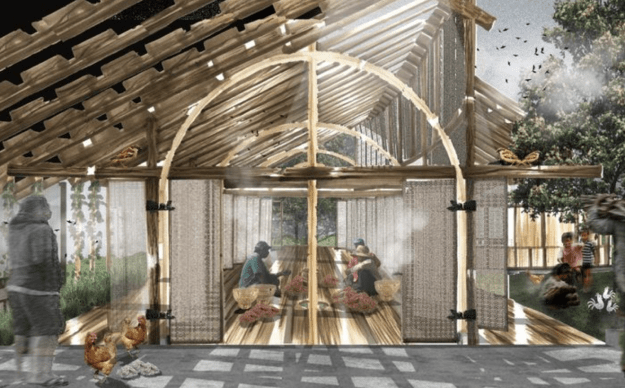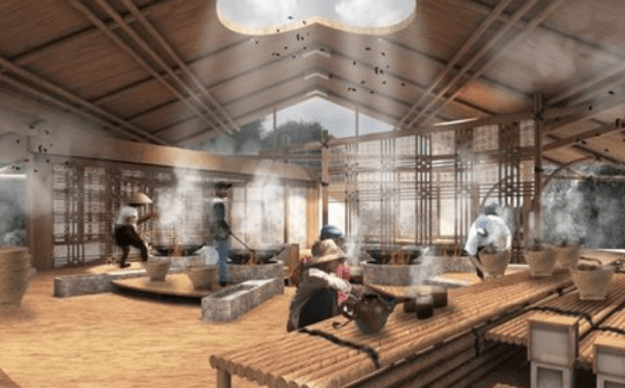BACK TO finale_winnerS
AYDA Designer of the Year
Rumah Kopi, Contextual Dwelling
Humans have the natural instinct for closeness with nature. Human’s interaction with nature rises human’s creativity to create personal perimeter. The tedium of living in the cities with towering buildings causes the owner of Refugees Coffee Shop to lose their closeness to nature. Coming from their need to develop a sustainable coffee business, an idea to design a coffee house (Rumah Kopi) in a secluded village was bord. The idea is to do collaboration with the villagers in cultivating and processing local coffee fruit into superior coffee bean. Its goal is to realize the vision to dwell in line with context; environmentally, socially, and culturally. Rumah kopi is also in hopes of achieving the initiator’s noble cause of maintaining sustainability and prospering the people of the village.

The background difference between city folk initiator and village inhabitants creates cultural acculturation, which supposed to respect the local culture. This will enable the initiators to live in harmony with the village natives. From the research’s result, it is possible to prove vernacular architecture’s role to create a contextual and sustainable dwelling space. It also shows the existence of Rumah Kopi might be a new form of dwelling space as a contemplative space of human in nature, a cultural center for its people, and also an economical icon of Kampung Buni Kasih. The concept of contextual dwelling of Rumah Kopi is to be a home that would sit well within its local and also adapt to accommodate local gatherings. Being contextual means being in line with where it is build, which in this case how to respect the local’s and their believes, site’s history, and how to preserve its essence. From 7 elements fo forming local culture, it is show that nature is the most important at Kampung Buni Kasih. The believes of “mengambil sambil menanam” means not to exploit nature, show through how the locals wisely built their house, their local gesture and ergonomics.



The background difference between city folk initiator and village inhabitants creates cultural acculturation, which supposed to respect the local culture. This will enable the initiators to live in harmony with the village natives. From the research’s result, it is possible to prove vernacular architecture’s role to create a contextual and sustainable dwelling space. It also shows the existence of Rumah Kopi might be a new form of dwelling space as a contemplative space of human in nature, a cultural center for its people, and also an economical icon of Kampung Buni Kasih. The concept of contextual dwelling of Rumah Kopi is to be a home that would sit well within its local and also adapt to accommodate local gatherings. Being contextual means being in line with where it is build, which in this case how to respect the local’s and their believes, site’s history, and how to preserve its essence. From 7 elements fo forming local culture, it is show that nature is the most important at Kampung Buni Kasih. The believes of “mengambil sambil menanam” means not to exploit nature, show through how the locals wisely built their house, their local gesture and ergonomics.


The final acculturation form of Rumah Kopi appears to be both strange and familiar focal point to the locals yet the entire project is possible to built by local carpenters and farmers. This acculturation form comes a translation of this project narrative and the material exploration, applied on social area (communal space and coffee experiment pantry) which becoming the center of the perpendicular axis.
Overall, it is not just a dream to dwell in nature, Rumah Kopi becoming a milestone in prospering and maintaining the sustainability of Kampung Buni kasih, the pride of the village, the new center of economical industry of the village.
Rumah Kopi and it sense of place.
Showcase your design to an international audience
SUBMIT NOW
Image: Agrapolis Urban Permaculture Farm by David Johanes Palar
Top
The background difference between city folk initiator and village inhabitants creates cultural acculturation, which supposed to respect the local culture. This will enable the initiators to live in harmony with the village natives. From the research’s result, it is possible to prove vernacular architecture’s role to create a contextual and sustainable dwelling space. It also shows the existence of Rumah Kopi might be a new form of dwelling space as a contemplative space of human in nature, a cultural center for its people, and also an economical icon of Kampung Buni Kasih. The concept of contextual dwelling of Rumah Kopi is to be a home that would sit well within its local and also adapt to accommodate local gatherings. Being contextual means being in line with where it is build, which in this case how to respect the local’s and their believes, site’s history, and how to preserve its essence. From 7 elements fo forming local culture, it is show that nature is the most important at Kampung Buni Kasih. The believes of “mengambil sambil menanam” means not to exploit nature, show through how the locals wisely built their house, their local gesture and ergonomics. The background difference between city folk initiator and village inhabitants creates cultural acculturation, which supposed to respect the local culture. This will enable the initiators to live in harmony with the village natives. From the research’s result, it is possible to prove vernacular architecture’s role to create a contextual and sustainable dwelling space. It also shows the existence of Rumah Kopi might be a new form of dwelling space as a contemplative space of human in nature, a cultural center for its people, and also an economical icon of Kampung Buni Kasih. The concept of contextual dwelling of Rumah Kopi is to be a home that would sit well within its local and also adapt to accommodate local gatherings. Being contextual means being in line with where it is build, which in this case how to respect the local’s and their believes, site’s history, and how to preserve its essence. From 7 elements fo forming local culture, it is show that nature is the most important at Kampung Buni Kasih. The believes of “mengambil sambil menanam” means not to exploit nature, show through how the locals wisely built their house, their local gesture and ergonomics. The final acculturation form of Rumah Kopi appears to be both strange and familiar focal point to the locals yet the entire project is possible to built by local carpenters and farmers. This acculturation form comes a translation of this project narrative and the material exploration, applied on social area (communal space and coffee experiment pantry) which becoming the center of the perpendicular axis. Overall, it is not just a dream to dwell in nature, Rumah Kopi becoming a milestone in prospering and maintaining the sustainability of Kampung Buni kasih, the pride of the village, the new center of economical industry of the village. Rumah Kopi and it sense of place.



